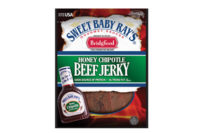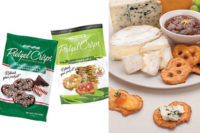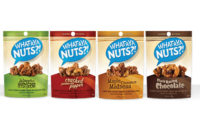“The overall trend we see is that it’s still a healthy category,” says Anna Kan, president of Universal Food Co., maker of Golden Island Gourmet Snacks. “It has definitely come a long way in the last 10 to 15 years and is now known as a high-protein, healthy snack that’s low in carbs and fat. People generally do think of it as a better protein then, say, chips or some of the other snacks. We think there’s great potential in this category.” Based in Rancho Cucamonga, Calif., Universal Food has been offering its soft and flavorful Golden Island beef and pork jerky since 2002.
Jerky has several other attributes that a growing number of consumers are discovering: It’s convenient and portable; usually doesn’t require refrigeration; and comes in a wide range of traditional and intriguing, ethnic flavors.
Changing tastes
Universal Food’s revamped the Golden Island line, which rolled out in June, and features beef and pork jerky in new flavors such as Chili Lime, Hickory Black Pepper, Grilled Barbecue, Korean Barbecue, Mandarin Orange and Teriyaki. “People’s tastes are changing,” says Kan. “As a culture, we’re becoming more experimental with flavors, and we’re tapping into that. Our Chile Lime is very popular with the Hispanic population. One of our newest successes is our Korean Barbecue, which tastes just like the Korean barbecue that you would go to a restaurant to eat. We’re doing really well with it.”
Besides adding new flavors to its Golden Island line, Universal Food has also cleaned up its labels. “We’ve taken out nitrites and nitrates,” says Kan. “We are in the final stages of pretty much going all-natural. That’s definitely a consumer demand. Consumers want not just high protein, but better health benefits. Our jerky is also 50% less sodium compared to other jerky products.”
A newly redesigned, resealable package holds 3 oz. of beef or pork jerky. The product is available in select Costco stores in Northern and Southern California, Hawaii, Las Vegas and Texas and on the East Coast; in select stores in Canada; and online at Amazon and the company’s website.
A ‘natural’ athlete
Another California jerky manufacturer, Krave Pure Eats Inc. in Sonoma, Calif., launched its all-natural Krave Jerky in January 2012. “Krave Jerky is our first product line and, as our initial offering, it speaks not only to our Wine Country heritage, but it also shows our willingness to go outside of the box to create a healthy and delicious snack,” says founder and CEO Jonathan Sebastiani.
The Krave line boast eight savory flavors: Beef Chili Lime, Beef Sweet Chipotle, Beef Garlic Chili Pepper, Beef Pineapple Orange, Beef Curry, Pork Smoky Grilled Teriyaki, Turkey Basil Citrus and Turkey Lemon Garlic.
“Along with the rollout of our all-natural products, we introduced all new packaging and branding,” Sebastiani explains. “The new design shows both the gourmet side and the healthy/all-natural side of our jerky, while still being artisanal and fun.”
Krave Jerky is available nationally through distributors, large chain stores (Safeway and Cost Plus World Market) and specialty retailers. The suggested retail price for a 3.25-oz. bag is $5.99-$6.99.
In response to consumer demand for healthier snacks with simpler, all-natural formulations, Oberto Brands, Kent, Wash., launched its Oh! Boy Oberto All Natural jerky line last summer. The move “has resulted in a significant increase in sales compared to the year before,” says senior brand manager Kap Pitarys. “Currently, Oberto is the only major national jerky manufacturer with an all-natural line.”
The Oh! Boy Oberto All Natural jerky line features Original Beef Jerky, Peppered Beef Jerky, Teriyaki Beef Jerky, Hickory Beef Jerky, BBQ Pork Jerky, Teriyaki Turkey Jerky and Spicy Sweet Beef Jerky, which was added in March due to consumer demand for spicy products. According to Pitarys, the new flavor features Oberto’s signature, slow-roasted, smoky sweet flavor, accented with real chili pepper flakes for an extra sizzling kick.
When switching to all-natural in 2011, Oberto also redesigned its packaging. “The new packaging has simple, clean lines and highlights the all-natural aspect by calling out that the product is minimally processed, has no artificial ingredients and has no added preservatives,” explains Pitarys. In addition, the back of the packaging features a short list of simple and recognizable ingredients.
Oh! Boy Oberto All Natural jerky is available in many grocery, drug and convenience stores nationwide, as well as at all REI locations. The 3.25-oz. bag has a suggested retail price of $6.49.
Boulder, Colo.-based Thanasi Foods, meanwhile, is in the process of converting its line of Duke’s meat snacks to an all-natural platform, says vice president of sales Erik Havlick, adding that it will be the only comprehensive lineup of co-branded, all-natural products in the jerky category. “All we’re trying to do is pull all the things out of the process that you just don’t need,” he explains. “Things that don’t make you feel all that great—the nitrites, etc.”
The Duke’s line is “a brand rollup of a number of previous SKUs that had primarily been branded with a number of co-brands, [such as Kikkoman, Frank’s RedHot, Stubb’s and Jim Beam],” explains Havlick. “Unifying these different jerky lines under a cohesive brand umbrella has generated a fantastic response.”
Vension, elk and buffalo, oh, my!
While most jerky manufacturers are offering beef, pork and turkey jerky in a variety of traditional and innovative flavors, Up North Jerky Outlets, Troy, Mich., recently introduced a line of wild game jerky in three flavors. The Gourmet Gold Series features venison, elk and buffalo jerky in Original, Hot and Cherry Maple.
According to CEO Paul Lyons, the company decided to add wild game jerky to its line of beef jerky, turkey jerky and jerky sausage because “it’s popular and some people like to try things that are unusual. Hunters and people who appreciate those kinds of things don’t have it all the time, even if they have [wild game] that they’ve obtained themselves.”
Lyons describes the product as “a very tender, moist venison, elk and buffalo jerky that’s superior in many ways to the overly dried-out product [commonly available].” However, because the cuts of meat are thicker and the drying process is not taken to completion, Gourmet Gold Series “fresh jerky” is not shelf-stable and requires refrigeration.
Gourmet Gold venison, elk and buffalo jerky is available only through the company’s website, not in its Beef Jerky Outlet stores. Half-pound bags retail for $24.99.
Growing category
Given consumers’ positive perception of jerky, the number of all-natural products available and the selection of meats and flavorings, it’s no wonder that jerky continues to grow as a category.
“The amount that we sell in our stores around the country is just remarkable and just keeps growing,” says Lyons. “We keep opening more franchise stores, and the trend is that people can’t get enough of it.”
Oberto’s Pitarys concurs: “The meat snack industry performed well in 2011 and is continuing to grow year-to-date in 2012. Oberto outperformed the category in the last year, following the launch of the All Natural line.”
According to Kan, “as an industry, [jerky] has grown 65% over the last nine years, according to our research. For us, personally, we were up 64% last year, and we’re expected to do 50% this year, so we’re definitely rapidly growing.”
Kan attributes some of this growth to female consumers. “[This category] is really moving demographically away from this blue-collar, young male-dominated consumer,” she explains. “What we find is that women are buying it, either for their own consumption or their husband’s.”
When buying jerky for themselves, women tend to seek out jerky with a sweeter, easy-to-chew profile. “Our pork jerky has a very soft, sweet profile that’s attractive to women and kids—the demographic that we’re going after,” Kan adds.
Potential hurdles
Despite this positive outlook for the jerky category, jerky manufacturers may be leaping a few hurdles in the coming year.
“I think the category will be challenged by retail price points,” says Thanasi’s Havlick. “We’ve seen year-over-year increases in the commodity, which is, of course, translated into price increases from manufacturers across the board. So now, when you look at the primary size driver in meat snacks, which is that 3-4 oz. bag size, it’s pushing that $7 price point. In many environments, we’re well more than $7. That’s a difficult thing for consumers to stomach when they don’t necessarily understand the amount of beef that it may take to dry down into a dried meat snack and what it takes to create that product.
“I think we’ll see the industry respond to that challenge in a couple of ways. We’ll see a lot more private-label players in meat snacks, and we’ll see more large, value or bulk offerings. That mainstay—the 3-4 oz. natural-style jerky size—has seen some modest growth in the last 52 weeks. I think it will stay modest for the foreseeable future, unless we can begin to talk to new age groups, new demographics and new ethnic groups. That’s a challenge we collectively have as a category.”
Ashley Brandt, brand manager for Minong, Wis.-based Jack Link’s Beef Jerky, the leading U.S. maker of meat snacks, agrees. “Some of the bigger challenges that we will be facing are the cost of beef, and that’s something that we’re always watching,” he says. “The other one is just staying on top of the trends and being as relevant as possible. Right now, we’re definitely an on-trend snack and, as a leader in the category, we believe that we owe it to the category to maintain that relevance with new and innovative products. That’s the challenge—figuring out what those next key things are that consumers are going to want and delivering new products against those.”
“It’s a constant battle,” says Lyons about meat costs. “The raw material is prime cuts of meat, which is going to have its own expense. Then, turning it into jerky, you lose about half of its weight. Any kind of a tick up in the price of the raw materials ends up being doubled by the time it comes out the other end.
“We’ve had some wild swings in pork products [pricing] over the last year, but they’ve stabilized and come down now. Beef is [priced] a little on the higher side from where it might be traditionally, but it has stabilized and trended in a very narrow range over the last six months to a year. We were warned that it was going to go way up, but that never quite happened, so that’s a good thing.”
Given consumers’ favorable perception of jerky and meat snacks and the jerky manufacturers’ focus on developing even healthier, more flavorful products, the coming year looks like a winner for the jerky category.
Small, But Satisfying |
|
Not all consumers who crave a meat snack want something as filling as jerky or beef sticks. Sometimes, just a bite or two of a small, savory, meat-filled product is enough to satiate them. El Monterey Mini Tacos from Ruiz Food Products Inc., Dinuba, Calif., offer light, between-meal nibblers an alternative. Introduced at retail the first quarter of 2012, El Monterey Chicken and Monterey Jack Cheese Mini Tacos and El Monterey Beef and Cheddar Cheese Mini Tacos [see the June 2012 issue of Snack Food & Wholesale Bakery, page 54] are made with real cheese, quality proteins, spices and fresh tortillas made exclusively in the company’s onsite bakery. They come in two sizes: A 15-count, 15-oz. resealable bag (traditional grocery stores nationwide); and an 18-count, 18-oz. resealable bag (in Walmart stores nationwide). The 15-oz. bag retails for $6.49 to $7.49, while the 18-oz. bag sells for $6.98. “Today’s mainstream consumer can’t get enough Mexican food,” says Kim Ruiz Beck, chairman. “Consumers enjoy it when they travel, when they treat themselves to an evening out, at home when they entertain and snack or gather as a family at the dinner table. “For our El Monterey brand, our sales are driven because we provide good-tasting Mexican food for the entire family. Our foods are consumed at every meal and snacking occasion and, as you know, snacking has become the fourth meal of the day.” Beck expects continued growth in the coming year, as consumers resume snacking as the economy bounces back. “Growth can also be attributed to innovation and more added-value intros in the category,” she says. “Snacking is becoming a key component for consumers, with consumers being more receptive to new products to meet their in-between meal needs. “Second, we have a broad market for our product. Our insights into the demographic and behavior stage of category and brand users shows that frozen Mexican snacks and meals are consumed across the lifespan–children, teens and adults—and across households–singles, couples and families. Additionally, Ruiz’s proprietary research with category and brand users shows that our products are eaten at a wide variety of occasions, including on-the-go meals, lunch at home and at work, afternoon and evening snacking, dinner for one, family dinners, party food for guests and sporting and entertainment venues.” |










